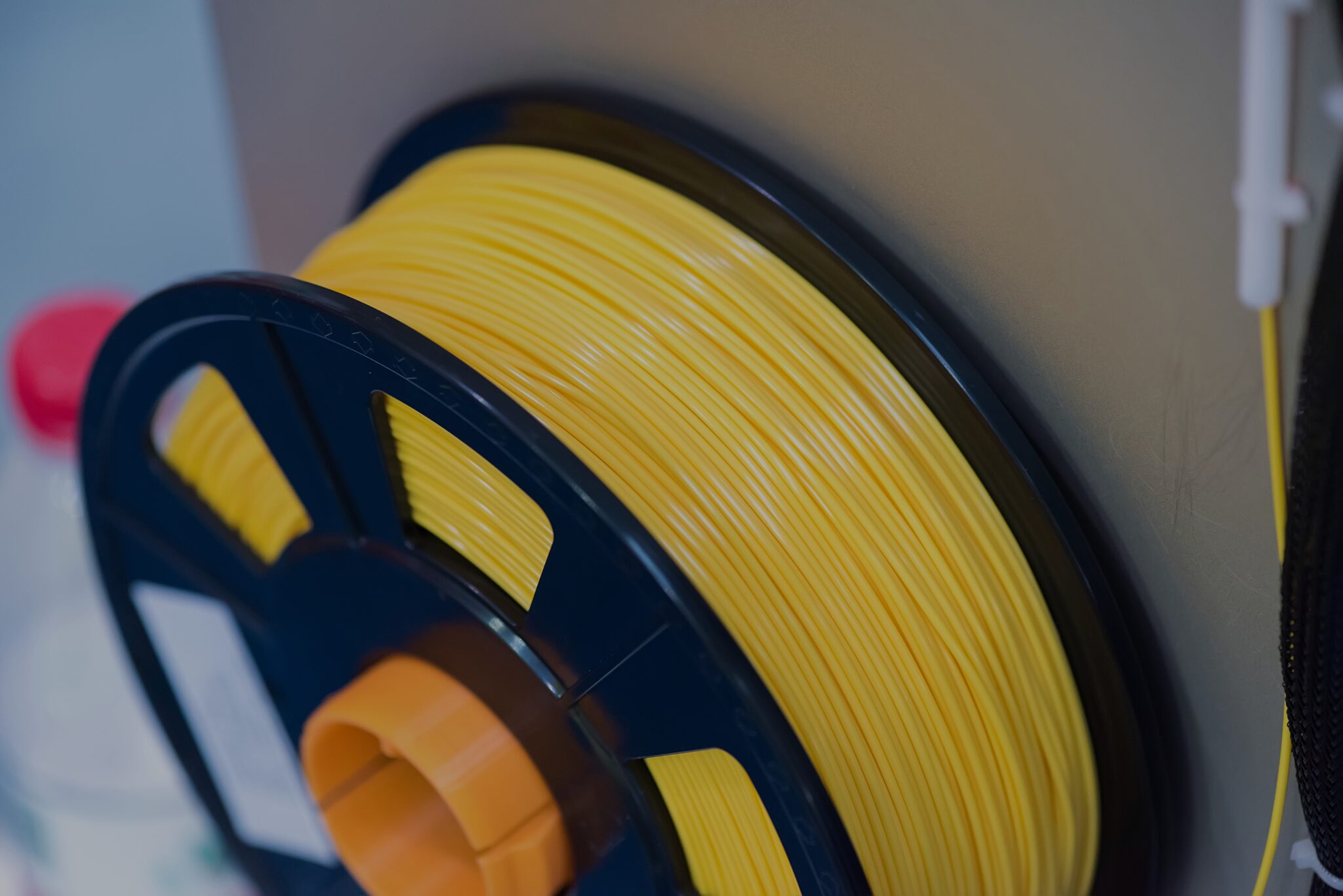

Previously published on fastradius.com on October 22, 2020
3D printing filaments are the raw material, or feedstock, specifically used in conjunction with fused deposition modeling (FDM), one of the most commonly used additive manufacturing methods. Filaments are thermoplastics that become liquid when heated — allowing them to be shaped and molded — and solid when cool. There are a variety of different types of filaments, each of which guarantees a specific set of material properties — some are extremely flexible and rubber-like, others are rigid, and some are even dissolvable or biodegradable.
The process of creating 3D printing filament begins with raw, granulated resin — such as PLA or ABS. Depending on the part application, the resin is first mixed with pigment and other additives to give the filament the desired color and material properties. To maximize quality, the filament will generally be dried at around 60-80°C in order to reduce the water content of the material, mitigating the occurrence of dimensional flaws.
The resin is then placed in a single-screw extruder that heats and mixes the material into a single monofilament, which is then run through a hot water tank and gently cooled, giving the filament its round shape. Improper water temperatures can result in flat or oval-shaped filament and — by extension — lower part quality. The filament passes through a final cold-water bath before spooling. The material is then ready to be used in production.
Since filaments vary in their material characteristics — and will therefore impact the functionality and aesthetics of the final part — it’s important to choose the 3D printing filament best-suited for a particular application. Here’s what product teams need to know.
During production, an FDM printer will heat the thermoplastic filament to its melting point, then extrude it following the toolpath laid out by the part’s CAD file. The method works by creating the part one layer of material at a time.
When choosing a material for a given part:
Three of the most commonly used 3D printing filaments are ASA, PETG, and polycarbonate, each of which comes with specific benefits and manufacturing considerations.
Acrylonitrile styrene acrylate (ASA) filament offers a unique blend of strength, dimensional stability, and UV, moisture, and chemical resistance, making it an ideal choice for 3D prototyping, outdoor applications, housing components, and automotive parts. ASA is more expensive and has a higher melting point than other common thermoplastics, and should only be printed in extremely well-ventilated areas, as the production process can release toxic fumes. It is an extremely temperature-sensitive material, and improper configuration of the FDM printer’s heating chamber can cause warp or layer separation.
PETG filament is crafted by incorporating glycol into polyethylene terephthalate (PET), a form of polyester used in many consumer packaged goods, including water bottles and food containers. This creates a clearer, more flexible filament that’s easier to print and has better thermal properties, resulting in significantly less warp or shrinkage as the material cools. PETG is also extremely impact-resistant, making it ideal for tooling, as well as manufacturing mechanical parts, prosthetics, and components designed to protect other parts.
However, PETG is hygroscopic, meaning that it absorbs humidity from its environment, and therefore must be stored in a cool, dry place. If the printer is not properly configured, PETG can also be prone to stringing, which negatively impacts print accuracy. PETG also resists adhesives and therefore requires additional treatment if painting or gluing is required.
Polycarbonate (PC) is one of the strongest 3D printing filaments available, offering high heat and impact resistance, as well as impressive dimensional stability. This makes it well-suited for parts that will need to stand up to high stress or load-bearing environments. PC is naturally transparent and therefore is often used to manufacture items like sunglass lenses and the screens of electronic devices. Like PETG, PC is also hygroscopic.
PC has a very high melting point, which can lead to a number of complications during production, including warping, splitting, and delaminating. For this reason, a fully enclosed, temperature-controlled FDM printer is ideal for printing PC parts.
FDM is one of the most common forms of 3D printing for both hobbyists and professional manufacturers, and can be used to create a variety of viable end-use parts. ASA, PETG, and PC are among the most common filaments and each provide a distinct set material characteristics. Determining the ideal filament for a given application is critical to creating superior, high-performance parts.
Partnering with a seasoned digital manufacturing partner like SyBridge can simplify the filament selection process. We bring years of experience to every job, leveraging our collective expertise to streamline the production lifecycle. We believe in maximizing efficiency without sacrificing quality, and that’s why we work closely with each of our customers from design to fulfillment in order to deliver parts of unmatched quality at competitive rates. Contact us today to discover the SyBridge difference.
Forget typical cycle times. We're pushing the boundaries of conformal cooling. While traditional approaches deliver…
Forget typical cycle times. We're pushing the boundaries of conformal cooling. While traditional approaches deliver…
From left to right: Brayden Janak (apprentice); Logan Vifaquain (CNC machining, Programming and CMM); Ron…
SyBridge Technologies is proud to announce we have been awarded the 2023 General Motors Supplier…
Today, designers and engineers are accustomed to working with digital tools in their day-to-day jobs.…
Optimizing Your Injection Molding Process for Cost-Effective Manufacturing Excellence In today’s competitive landscape, manufacturers are…